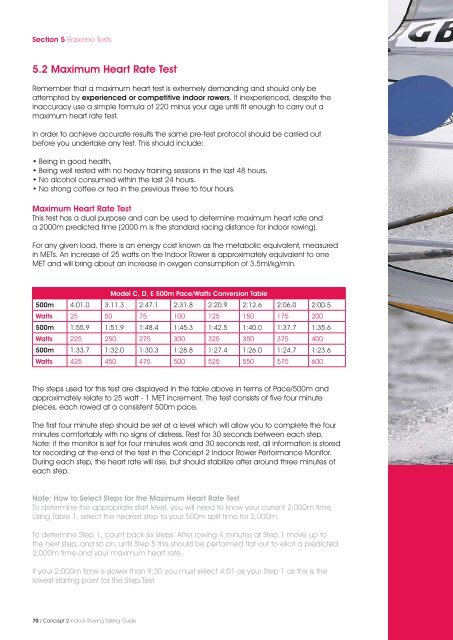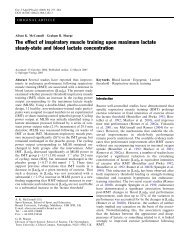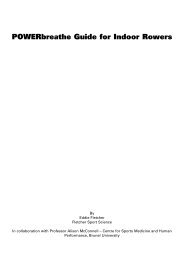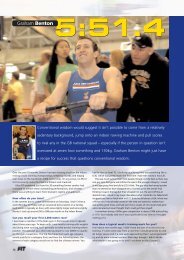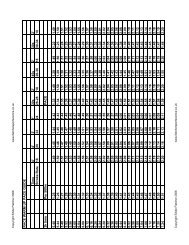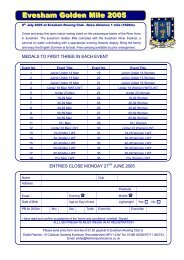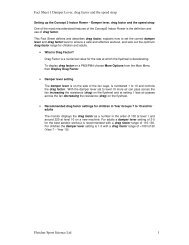Concept2-Sailing Rowing Guide.indd - Fletcher Sport Science
Concept2-Sailing Rowing Guide.indd - Fletcher Sport Science
Concept2-Sailing Rowing Guide.indd - Fletcher Sport Science
Create successful ePaper yourself
Turn your PDF publications into a flip-book with our unique Google optimized e-Paper software.
Section 5 Baseline Tests<br />
5.2 Maximum Heart Rate Test<br />
Remember that a maximum heart test is extremely demanding and should only be<br />
attempted by experienced or competitive indoor rowers. If inexperienced, despite the<br />
inaccuracy use a simple formula of 220 minus your age until fit enough to carry out a<br />
maximum heart rate test.<br />
In order to achieve accurate results the same pre-test protocol should be carried out<br />
before you undertake any test. This should include:<br />
• Being in good health.<br />
• Being well rested with no heavy training sessions in the last 48 hours.<br />
• No alcohol consumed within the last 24 hours.<br />
• No strong coffee or tea in the previous three to four hours.<br />
Maximum Heart Rate Test<br />
This test has a dual purpose and can be used to determine maximum heart rate and<br />
a 2000m predicted time (2000 m is the standard racing distance for indoor rowing).<br />
For any given load, there is an energy cost known as the metabolic equivalent, measured<br />
in METs. An increase of 25 watts on the Indoor Rower is approximately equivalent to one<br />
MET and will bring about an increase in oxygen consumption of 3.5ml/kg/min.<br />
Model C, D, E 500m Pace/Watts Conversion Table<br />
500m 4:01.0 3:11.3 2:47.1 2:31.8 2:20.9 2:12.6 2:06.0 2:00.5<br />
Watts 25 50 75 100 125 150 175 200<br />
500m 1:55.9 1:51.9 1:48.4 1:45.3 1:42.5 1:40.0 1:37.7 1:35.6<br />
Watts 225 250 275 300 325 350 375 400<br />
500m 1:33.7 1:32.0 1:30.3 1:28.8 1:27.4 1:26.0 1:24.7 1:23.6<br />
Watts 425 450 475 500 525 550 575 600<br />
The steps used for this test are displayed in the table above in terms of Pace/500m and<br />
approximately relate to 25 watt - 1 MET increment. The test consists of five four minute<br />
pieces, each rowed at a consistent 500m pace.<br />
The first four minute step should be set at a level which will allow you to complete the four<br />
minutes comfortably with no signs of distress. Rest for 30 seconds between each step.<br />
Note: if the monitor is set for four minutes work and 30 seconds rest, all information is stored<br />
for recording at the end of the test in the Concept 2 Indoor Rower Performance Monitor.<br />
During each step, the heart rate will rise, but should stabilize after around three minutes of<br />
each step.<br />
Note: How to Select Steps for the Maximum Heart Rate Test<br />
To determine the appropriate start level, you will need to know your current 2,000m time.<br />
Using Table 1, select the nearest step to your 500m split time for 2,000m.<br />
To determine Step 1, count back six steps. After rowing 4 minutes at Step 1 move up to<br />
the next step, and so on, until Step 5 this should be performed flat out to elicit a predicted<br />
2,000m time and your maximum heart rate.<br />
If your 2,000m time is slower than 9:30 you must select 4:01 as your Step 1 as this is the<br />
lowest starting point for the Step Test.<br />
70 / Concept 2 Indoor <strong>Rowing</strong> <strong>Sailing</strong> <strong>Guide</strong><br />
The following is an example of an indoor rower who rows 2,000m in 6:40<br />
Section 5 Baseline Tests<br />
Average 500m split = 1:40<br />
Starting level (Step 1) is six steps back = 2:00.5<br />
Step 2 = 1:55.9<br />
Step 3 = 1:51.9<br />
Step 4 = 1:48.4<br />
Step 5 is rowed flat out to give a predicted 2,000m time and maximum heart rate<br />
For practical purposes the pace for each step should be rounded to the nearest second.<br />
Concept 2 Indoor <strong>Rowing</strong> <strong>Sailing</strong> <strong>Guide</strong> / 71


